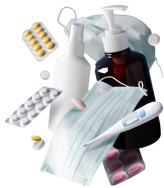Healthwire Pharmacy provides 100% genuine medicines straight to your doorstep.
Order Now! & Avail
Upto 10% OFF On All Your Pharmacy Orders!
Citalopram 10mg
Healthwire Pharmacy Ratings & Reviews (1500+)
Product Information
Citalopram's primary mechanism of action is as a selective serotonin reuptake inhibitor (SSRI). It works by blocking the reabsorption of serotonin in the brain, which increases the availability of serotonin in the synaptic cleft. Serotonin is a neurotransmitter that plays a crucial role in regulating mood, emotions, and anxiety. By inhibiting the reuptake of serotonin, citalopram enhances serotonergic activity, leading to improved mood and a reduction in anxiety symptoms. This is achieved by blocking the serotonin transporter (SERT), a protein responsible for the reuptake of serotonin, thereby increasing serotonin levels in the synaptic cleft and promoting neurotransmission. The enhanced serotonin levels help regulate mood and alleviate symptoms associated with depression and anxiety disorders.
Citalopram 10mg
Antidepressant
Tablet
The following are the uses of Citalopram 10mg Tablet:
In the case of an overdose of Citalopram 10mg, symptoms may include dizziness, drowsiness, nausea, vomiting, sweating, rapid heartbeat, tremors, confusion, seizures, and, in severe cases, cardiac arrhythmias or loss of consciousness. If an overdose is suspected, seek immediate medical attention to prevent serious complications and ensure proper treatment.
In the case of a missed dose of Citalopram 10mg Tablet, it is important to take the missed dose as soon as you remember. However, if it is almost time for your next scheduled dose, skip the missed one. Never double the dose to make up for a missed one, as this may increase the risk of side effects. If you miss multiple doses, contact your healthcare provider for guidance on how to safely resume your medication schedule without compromising your treatment plan. It's best to set a daily routine to help you remember to take your medication at the same time each day.
To take Citalopram 10mg Tablets, swallow the tablet whole with a full glass of water, preferably in the morning or as directed by your healthcare professional, without crushing or chewing, and follow the prescribed dosage instructions provided by your doctor.
Here are the situations when Citalopram 10mg Tablet should not be used:
The side effects of Citalopram 10mg Tablet may include:
Following are the precautions and warnings for Citalopram 10mg Tablet:
Following are the drug interactions for Citalopram 10mg Tablet:
Following are the food interactions for Citalopram 10mg Tablet:
Citalopram 10mg Tablets should be stored in a secure and dry location, preferably in a medicine cabinet, away from direct sunlight, moisture, and heat sources like ovens or radiators. Keep the tablets in their original container, tightly sealed, to maintain their integrity and prevent contamination. It's crucial to regularly check the expiration date, ensuring you don't use the medication beyond this date. When disposing of unused or expired tablets, avoid flushing them down the toilet or pouring them into drains. Instead, consult your pharmacist or healthcare provider for safe disposal methods, as they can guide you on local regulations and environmentally friendly practices. Keep the medication out of children's reach to prevent accidental consumption, ensuring their safety.
Following are the quick tips for Citalopram 10mg Tablet:

Order Now! & Avail
Upto 10% OFF On All Your Pharmacy Orders!

If you face any issue, feel free to contact us. We provide 24/7 support to assist your problems